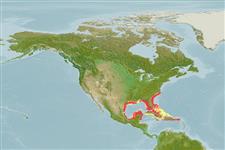Environment: milieu / climate zone / depth range / distribution range
Ökologie
seewasser riff-verbunden; standorttreu; tiefenbereich 2 - 92 m (Ref. 9710), usually 5 - 25 m (Ref. 9761). Subtropical; 35°N - 18°N, 100°W - 64°W (Ref. 55264)
Western Atlantic: Bermuda, Bahamas and off southern Florida, USA to the Gulf of Mexico, including Yucatan, Mexico (Ref. 26938).
Size / Gewicht / Alter
Maturity: Lm ? range ? - ? cm
Max length : 45.0 cm TL Männchen/unbestimmt; (Ref. 4858); common length : 35.0 cm TL Männchen/unbestimmt; (Ref. 3797)
Soft parts of dorsal and anal fins and caudal fins have wide yellow margins. Dark spot on forehead lacks electric blue ring. Juveniles blue, banded, with last prominent band straight (Ref. 26938). The pectorals are blue basally, clear distally, with a broad yellow band separating the two colors; the pelvic fins are light yellow (Ref. 13442).
Inhabits rocky or coral reefs (Ref. 9710). Juveniles in channels and on inshore reefs (Ref. 9710). Feeds primarily on sponges (Ref. 9710). Small juveniles do well in aquariums once they begin to accept food.
Life cycle and mating behavior
Geschlechtsreife | Fortpflanzung | Ablaichen | Eier | Fecundity | Larven
Allen, G.R., 1985. Butterfly and angelfishes of the world. Vol. 2. 3rd edit. in English. Mergus Publishers, Melle, Germany. (Ref. 4858)
IUCN Rote Liste Status (Ref. 130435)
Bedrohung für Menschen
Reports of ciguatera poisoning (Ref. 30303)
Nutzung durch Menschen
Fischereien: weniger kommerziell; Aquarium: Kommerziell
Mehr Information
NamenSynonymeMetabolismusRäuberÖkotoxikologieFortpflanzungGeschlechtsreifeAblaichenSpawning aggregationFecundityEierEientwicklung
ReferenzenAquakulturAquakultur ProfilZuchtlinienGenetikElectrophoresesVererbbarkeitKrankheitenVerarbeitungNutrientsMass conversion
Tools
Zusatzinformationen
Download XML
Internet Quellen
Estimates based on models
Preferred temperature (Ref.
123201): 23.4 - 27.4, mean 24.6 °C (based on 208 cells).
Phylogenetic diversity index (Ref.
82804): PD
50 = 0.5078 [Uniqueness, from 0.5 = low to 2.0 = high].
Bayesian length-weight: a=0.03162 (0.01607 - 0.06223), b=2.88 (2.71 - 3.05), in cm total length, based on LWR estimates for this species & (Sub)family-body (Ref.
93245).
Trophic level (Ref.
69278): 3.0 ±0.0 se; based on diet studies.
Widerstandsfähigkeit (Ref.
120179): sehr niedrig, Verdopplung der Population dauert mehr als 14 Jahre. (Preliminary K or Fecundity.).
Fishing Vulnerability (Ref.
59153): Low to moderate vulnerability (35 of 100).
Nutrients (Ref.
124155): Calcium = 23.2 [10.6, 42.9] mg/100g; Iron = 0.487 [0.280, 0.845] mg/100g; Protein = 19 [18, 20] %; Omega3 = 0.151 [0.087, 0.259] g/100g; Selenium = 18.6 [8.8, 40.2] μg/100g; VitaminA = 35.5 [8.6, 142.2] μg/100g; Zinc = 0.782 [0.509, 1.170] mg/100g (wet weight);
